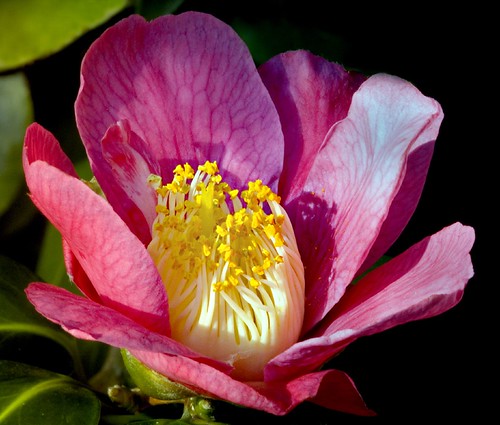Meta information: Nikon D70 Raw capture, AF Micro Nikkor 105mm f/2.8 (157mm 35mm equivalence) with 36mm (3X) Kenko extension tube.
Exif: ISO 200, 1/5 second, f/36. This was an exterior shot in windy conditions using a tripod that required patience (many shots in the series did not work because the flower had moved during the 1/5 second exposure), but I did want to stop the lens down for high depth of field and apparent sharpness.
Focus: Manual, about 0.2 meter (around 8 inches) from the subject.
Post: Cropping for compostion, routine level adjustments and workflow, sharpening for Gaussian blur, and color enhancement with a graduated dark blue overlay in Photoshop.
I love old-fashioned camellias, like the blossom in this photo that I took a few days ago.
This is the time of year around here that camellias start to bloom. These wonderful flowering bushes, closely related to the tea plant, bloom through the middle of the spring. We are lucky enough to have four mature and very productive camellias in the front garden of our house.
Camellias are the Tsubaki of Japan, and were first brought to Europe in the 1700s. They made it to the United States in the mid-eighteenth century, and to the Bay area following the gold rush–where they are deservedly a cult flower with an immense number of varieties. But my personal choice is for the simpler, more old-fashioned varieties like this one.
Here’s a nifty timeline of the history of western cultivation of the camellia.

Pingback: Photoblog 2.0: » Photoblog 2.0 Archive: » In the Bag